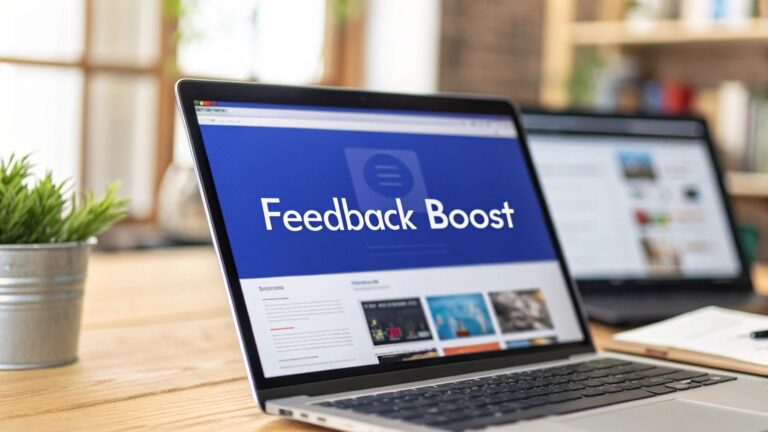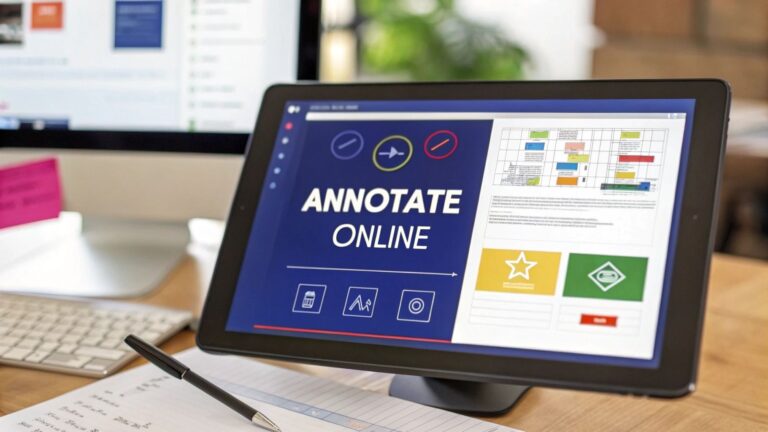The Hidden Cost of Collaboration Breakdowns
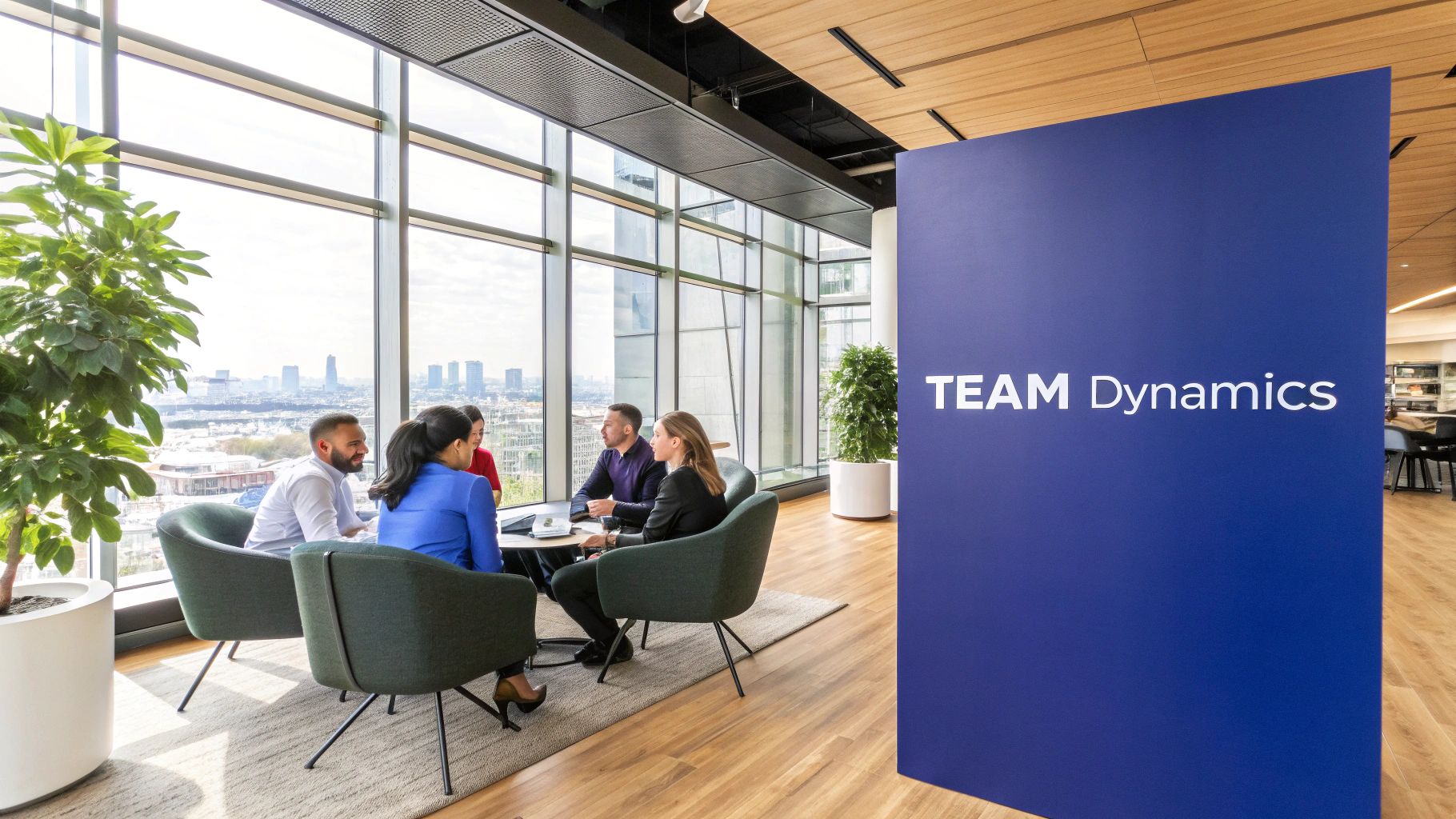
When teams struggle to collaborate, the consequences can be significant. This goes beyond simple frustration and missed deadlines. Poor collaboration translates directly into financial losses, hindering a company's overall progress and potential. Imagine a delayed product launch because marketing and development weren't on the same page. The result? Lost revenue and a damaged brand reputation. This makes improving team collaboration not just a desirable perk, but a business imperative.
Quantifying the Impact of Poor Collaboration
The consequences of poor teamwork are multifaceted, impacting everything from productivity to revenue. One of the most obvious effects is the loss of productivity. When teams lack alignment, valuable time is wasted clarifying misunderstandings, duplicating efforts, and searching for information. This inefficiency has a ripple effect, derailing project timelines and ultimately impacting organizational goals.
Poor collaboration also stifles innovation. When team members feel unheard or undervalued, they're less likely to contribute creative ideas. This can lead to stagnation and prevent companies from adapting to evolving market demands.
Furthermore, consistent collaboration breakdowns fuel employee dissatisfaction and increase turnover. When employees are perpetually frustrated by inefficient processes and communication barriers, they're more likely to seek new opportunities. This talent drain can be incredibly costly, requiring significant resources for recruitment and training. These seemingly small issues can snowball into major organizational challenges.
To illustrate these losses, let's examine some concrete data. The following table quantifies the concrete productivity losses resulting from ineffective team collaboration:
"Productivity Losses from Poor Collaboration"
| Impact Area | Percentage Affected | Weekly Time Lost | Annual Cost Impact |
|---|---|---|---|
| Project Delays | 70% | 3+ hours | Significant (estimated in millions for large organizations) |
| Duplicate Work | 50% | 2+ hours | Substantial (can reach hundreds of thousands for medium-sized businesses) |
| Miscommunication | 80% | 1+ hour | Notable (tens of thousands for small businesses and upwards) |
| Employee Turnover | 40% | Variable, but impacts onboarding and training costs | High (estimated in the thousands per employee lost) |
As you can see, the costs quickly add up. Investing in robust collaboration solutions is not just a cost, it's a strategic investment in your future.
A 2025 study highlighted the substantial impact of teamwork – both positive and negative – on employee performance and innovation. In strong collaborative environments, 73% of employees reported better performance and 60% felt more innovative. Conversely, 70% acknowledged poor collaboration's negative impact on their productivity, with 64% losing at least three hours weekly due to inefficiencies. Learn more about workplace collaboration statistics This lost time translates into major productivity losses, underlining the critical need for effective teamwork.
The Ripple Effect on Innovation and Talent
Beyond the immediate financial implications, poor collaboration can have a lasting impact on a company's ability to innovate and retain valuable employees. When teams operate in silos, knowledge sharing is limited, hindering the development of new ideas and innovative solutions. This can lead to missed opportunities and a decline in competitiveness.
Moreover, a lack of collaboration creates a negative work environment, leading to decreased morale and increased stress. This further exacerbates collaboration issues, creating a vicious cycle that negatively impacts both individual and organizational performance.
Improving team collaboration is not simply about increasing efficiency; it's about fostering a culture of open communication, mutual respect, and shared purpose. By investing in strategies and tools that facilitate effective teamwork – such as Slack for communication and Asana for project management – organizations can unlock their full potential, driving innovation, improving employee satisfaction, and achieving sustainable growth. This also includes implementing clear communication protocols and cultivating a supportive work environment.
Creating a Collaborative Culture That Actually Works
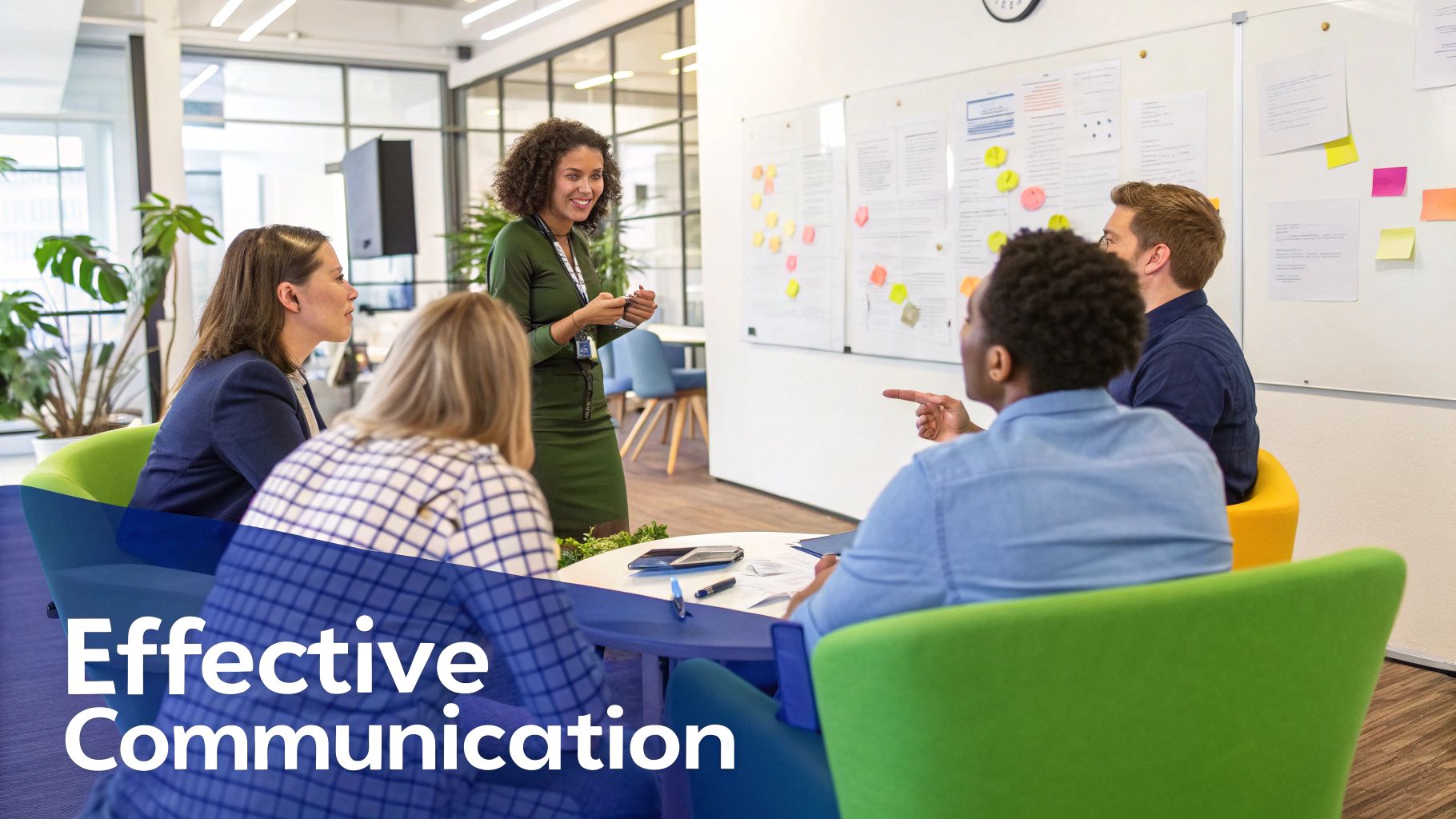
Forget superficial perks. True team collaboration isn't about ping-pong tables and trendy jargon. It's about fostering a genuine environment where teamwork thrives. This requires a deep understanding of how teams interact and achieve shared goals. The payoff? Increased productivity, boosted innovation, and a more engaged workforce.
Building Psychological Safety for Open Communication
Psychological safety is paramount to successful collaboration. It's the shared understanding that team members can speak freely, share ideas, and take risks without fear of repercussions. Imagine a team meeting where junior members hesitate to challenge a senior leader's proposal. This lack of psychological safety stifles innovation.
Conversely, when team members feel safe expressing themselves, diverse perspectives emerge. This leads to better decision-making and more creative solutions. Open communication fosters trust and mutual respect, building a positive and productive work environment.
Practical Frameworks for Daily Collaboration
Collaboration can't just be an abstract ideal. It needs to be put into daily practice using practical frameworks. These frameworks provide structure and guidance for team interaction, communication, and workflow. One example is establishing clear communication protocols.
This could involve defining preferred communication channels, setting response time expectations, or establishing regular check-in meetings. Using project management tools like BugSmash centralizes communication and feedback, keeping teams organized and focused on project goals. These frameworks turn collaboration into a concrete, actionable process. The result? Greater efficiency, fewer misunderstandings, and better team performance.
Leadership's Role in Modeling Collaboration
Leaders are vital in shaping collaborative culture. They must embody the behaviors they expect from their teams. This includes actively participating in collaborative activities, demonstrating open communication, and welcoming feedback. Leaders must address conflicts constructively and create systems that value diverse viewpoints.
Global workplace studies highlight the critical nature of collaboration. Gallup's 2023 research indicates low employee engagement, often linked to poor collaboration, costs the global economy an estimated $8.9 trillion annually – a staggering 9% of world GDP. This demonstrates the significant financial and operational impact of improving teamwork. Beyond finances, leadership’s commitment sets the tone for the whole organization, fostering a culture of teamwork and shared success, leading to a more positive and productive work environment.
Communication Techniques That Bridge Divides
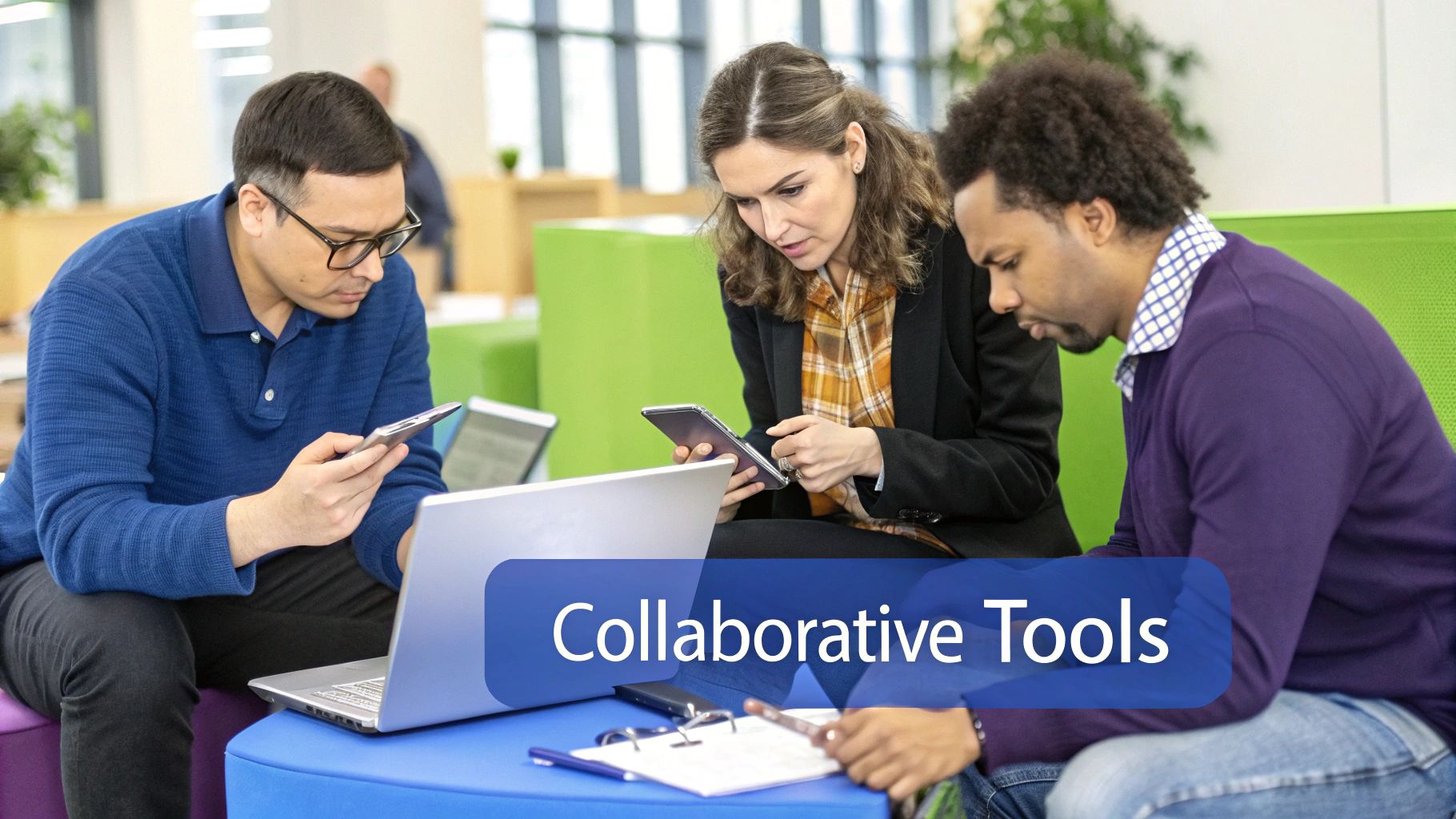
Team collaboration thrives on exceptional communication. But many teams, especially those working in hybrid environments, struggle to find the right balance. This section explores practical communication frameworks you can implement, regardless of your team's setup. We'll draw upon real-world examples from high-performing teams to empower your team to communicate better and achieve outstanding results.
Synchronous Vs. Asynchronous Communication: Choosing The Right Tool
Effective communication starts with knowing when to use synchronous communication (real-time) and asynchronous communication (delayed). Synchronous methods, like video conferencing, excel for brainstorming and decision-making. They encourage instant feedback and dynamic discussions. However, overuse can lead to workflow interruptions and decreased individual focus.
Asynchronous methods, like email or using project management tools like BugSmash, allow team members to contribute at their peak productivity. This fosters deep, focused work and minimizes disruptions. Striking the right balance is the key to maintaining project momentum without sacrificing crucial collaborative moments. Think of it this way: quick questions can be handled asynchronously, while complex problem-solving thrives on real-time interaction.
Structuring Meetings For Maximum Impact
Meetings are essential for teamwork, but they can easily become unproductive if poorly planned. Clearly defined agendas and time limits keep discussions on track and prevent unnecessary tangents. Assigning roles, such as a facilitator and note-taker, ensures everyone participates actively and contributes meaningfully.
Starting and ending on time demonstrates respect for everyone's schedule. Follow up with a concise summary of decisions made and action items assigned. This reinforces accountability and keeps the entire team moving forward. These practices transform meetings from time-wasters into powerful engines for collaboration and progress.
Ensuring Every Voice Is Heard
Successful team collaboration requires every member to feel heard and valued, especially in diverse teams with varied communication styles. Active listening is paramount. Show genuine interest in understanding different perspectives. This involves asking clarifying questions, paraphrasing to confirm understanding, and paying attention to nonverbal cues.
Create opportunities for all team members to contribute, irrespective of their communication style or seniority. This builds psychological safety, allowing individuals to share ideas openly, which leads to richer discussions and more innovative outcomes. A welcoming environment where everyone feels comfortable contributing unique insights fuels a more inclusive and collaborative culture. For further insights, explore our guide on effective feedback loops for software teams.
Overcoming Communication Barriers In Diverse Teams
Even with the best intentions, communication challenges can arise, particularly in geographically dispersed teams. Clear, accessible documentation ensures everyone has the same information and reduces confusion. Establish consistent communication protocols, such as preferred channels and expected response times, to streamline interactions and minimize misunderstandings.
Navigating time zone differences requires flexibility and thoughtful planning. Scheduling meetings at times convenient for all participants, or recording them for those unable to attend live, demonstrates consideration and inclusivity. Overcome these hurdles to build a more cohesive and productive team environment. Also, consider exploring how to master feedback with collaborative tools. By proactively addressing communication challenges, your team can strengthen relationships and drive better results.
Collaboration Technology That Enhances Human Connection

Technology should amplify, not replace, genuine human connection in team collaboration. With the multitude of tools available, choosing the right ones is paramount to improving workflows. This requires understanding your team's unique challenges and finding solutions that directly address them. This section explores how leading organizations are building integrated tech ecosystems that simplify, not complicate, team collaboration.
Evaluating Technology For Collaborative Success
The first step in enhancing team collaboration with technology is identifying your team's pain points. Are there communication breakdowns? Is project management a constant struggle? Are feedback loops inefficient? Once you've pinpointed the issues, you can evaluate tools based on their ability to provide practical solutions.
For example, if your team is struggling with feedback scattered across email, chat, and spreadsheets, a visual feedback tool like BugSmash can centralize this information. This reduces context-switching and streamlines the review process, making feedback actionable rather than overwhelming. You might be interested in: How to master feedback with collaborative tools. This focused approach ensures the technology serves your team, not the other way around.
Building An Integrated Tech Ecosystem
Successful organizations don't simply adopt individual tools; they build integrated tech ecosystems. This involves thoughtfully selecting tools that work seamlessly together, removing redundancy and optimizing workflows. It's like building a well-oiled machine, where every part functions in perfect harmony with the others.
This integration minimizes the need for constant app-switching and reduces the risk of information silos. A project management tool like ProofHub integrated with a communication platform, for instance, ensures that updates and feedback are easily accessible to everyone. This cohesive approach improves efficiency and cultivates better team communication.
To help you navigate the selection process, the following table compares several leading collaboration platforms:
Introduction: Choosing the right collaboration tools is a crucial step in building an effective team. The following table provides a detailed comparison of popular platforms, highlighting their strengths and weaknesses to help you make informed decisions.
| Tool Category | Best For | Key Features | Integration Capabilities | Implementation Complexity |
|---|---|---|---|---|
| Project Management | Managing tasks, timelines, and resources | Task assignments, Gantt charts, Kanban boards | Integrations with communication, file sharing, and CRM platforms | Varies depending on project size and team structure |
| Communication | Real-time messaging and file sharing | Instant messaging, group chats, video conferencing | Integrations with project management and other business tools | Typically straightforward |
| File Sharing | Storing and sharing documents | Version control, collaborative editing, secure access | Integrations with project management and communication platforms | Generally easy to implement |
Conclusion: As the table illustrates, each collaboration tool category offers distinct benefits and features. Selecting the right combination for your team depends on specific needs and workflows. Consider prioritizing tools that integrate seamlessly to create a cohesive and efficient tech ecosystem.
Implementation Strategies For Sustainable Adoption
Simply introducing new tools isn't enough; effective implementation requires a strategic approach. This means involving team members in the selection process and providing comprehensive training. Consider these strategies:
- Gradual Rollout: Start with a small pilot group to test and refine processes.
- Training and Support: Offer clear instructions and readily available resources.
- Feedback Loops: Encourage regular feedback to identify challenges and make adjustments.
These strategies ensure the technology becomes a valuable asset, transforming how teams collaborate. Research from 2024 underscores the importance of effective collaboration: 97% of employees and executives agree that misalignment negatively impacts project outcomes. Collaborative teams achieve 36% higher customer satisfaction and are 56% better at decision-making. Find more detailed statistics here. This data highlights the considerable benefits of prioritizing and improving team collaboration.
The Power of Human Connection In A Tech-Driven World
While technology plays a vital role, human connection remains the foundation of successful collaboration. Tools should facilitate, not replace, meaningful interaction. Encourage team members to connect personally, build rapport, and foster trust. This means prioritizing face-to-face interactions (even virtual ones) and cultivating a culture of empathy and open communication. By combining technology with a focus on human connection, you can create a truly collaborative and high-performing team.
Breaking Through Collaboration Barriers That Hold Teams Back
Even the most dedicated teams face obstacles that can stifle collaboration. Left unchecked, these barriers can severely impact productivity, innovation, and ultimately, success. This section explores common roadblocks to collaboration and offers practical solutions to overcome them, drawing on real-world examples and expert advice. By confronting these challenges directly, teams can unleash their full potential and achieve remarkable results.
Bridging Geographical Divides and Dismantling Silos
Geographical distance and departmental silos represent two major hurdles for effective teamwork. When team members are dispersed geographically or confined within their own departments, communication often suffers. This can lead to miscommunication, duplicated work, and lost opportunities.
Successful organizations tackle these challenges by implementing robust communication strategies. This might involve using tools like video conferencing and instant messaging to ensure constant contact, regardless of location. It also means fostering a culture of transparency where everyone has access to the information they need. Breaking down departmental silos requires actively promoting cross-functional collaboration, encouraging teams to collaborate on shared projects and goals.
Transforming Conflict Into Productive Discussion
Conflict is an unavoidable part of any team environment. But unresolved conflict can escalate quickly, harming relationships and hindering progress. Turning conflict into productive discussion is a crucial skill for improved team collaboration. This requires:
-
Active Listening: Truly hearing and understanding each other’s viewpoints.
-
Empathy: Recognizing and validating each other's feelings.
-
Open Communication: Expressing concerns and ideas in a respectful and constructive manner.
-
Focus on Solutions: Collaborating to find resolutions that benefit everyone.
By viewing conflict as a chance for growth and learning, teams can become stronger and more cohesive.
Aligning Incentives to Reward Collaborative Behaviors
Individual incentives can sometimes inadvertently discourage collaboration. When team members are rewarded solely for individual performance, they may be less likely to assist colleagues or contribute to shared objectives. To counteract this, leading organizations are shifting towards rewarding collaborative behaviors. This might involve implementing team-based bonuses, publicly acknowledging collaborative achievements, or incorporating collaboration into performance reviews. This reinforces the importance of teamwork and actively incentivizes it.
Early Warning Signs and Intervention Techniques
Recognizing the early warning signs of collaboration breakdown is paramount. These signs may include reduced communication, increased conflict, missed deadlines, or a decline in team morale. Once these signs are identified, swift intervention is crucial to get teams back on track. This could involve facilitating team-building exercises, offering conflict resolution training, or reevaluating team objectives and individual roles. These proactive steps prevent small issues from escalating into major problems, ensuring a healthy and productive team environment. Building cross-functional trust is also key. This means creating chances for team members from different departments to connect and work together, fostering rapport and mutual understanding. Remote team collaboration tools can enhance human connection through collaboration technology. By focusing on shared goals that transcend individual ambitions, teams can develop a sense of collective purpose, motivating collaborative efforts. Finally, in virtual environments, proactively nurturing connections is especially important. This could include virtual coffee breaks, online team-building activities, or dedicated channels for social interaction. These seemingly minor efforts can make a significant difference in improving team cohesion and communication.
Measuring What Matters: Collaboration Metrics That Drive Success
Improving team collaboration is a strategic imperative, not just a feel-good initiative. It requires a data-driven approach, because you can't improve what you don't measure. Yet, many organizations struggle to effectively evaluate their collaborative efforts. This section explores the qualitative and quantitative metrics that provide true insights, empowering teams to understand their strengths, address weaknesses, and chart a course toward collaborative success.
Key Metrics for Measuring Collaboration
Effective measurement starts with choosing the right metrics. These should align directly with your desired outcomes and typically fall into two categories: quantitative and qualitative.
-
Quantitative Metrics: These offer concrete, numerical data, allowing for objective tracking and analysis. Consider these examples:
- Project Completion Rate: This tracks the percentage of projects completed on time and within budget, providing a clear picture of collaborative efficiency.
- Number of Collaborative Projects: This measures the frequency of cross-functional teamwork, indicating how deeply collaboration is ingrained in your organizational culture.
- Time Spent on Collaborative Activities: This metric quantifies the resources dedicated to teamwork, highlighting potential areas for streamlining and optimization.
-
Qualitative Metrics: While not numerically driven, these metrics offer valuable subjective insights into the quality and impact of collaboration. Here are a few examples:
- Team Member Satisfaction Surveys: These surveys capture team members’ perspectives on collaboration, providing valuable feedback on what's working and what needs improvement. Tools like SurveyMonkey can be invaluable for gathering this data.
- Peer Feedback: Peer feedback offers a unique window into individual contributions and team dynamics, fostering a culture of continuous improvement.
- Qualitative Observations: Direct observation, through interviews or focus groups, can uncover rich, nuanced information about team dynamics and collaborative processes.
Establishing Meaningful Baselines and Gathering Actionable Insights
Before implementing any changes, establish meaningful baselines for your chosen metrics. Collect initial data to understand your current state of collaboration, creating a benchmark against which to measure future progress. For example, if your initial survey shows that only 60% of team members feel their voices are heard, that becomes your baseline for measuring the impact of communication improvements.
Actionable insights are the lifeblood of data-driven decision making. Go beyond vanity metrics, which may appear impressive but lack substance. For example, simply counting the number of meetings held doesn't equate to effective collaboration. Instead, focus on metrics tied directly to improved outcomes, such as project completion rates or team member satisfaction. These provide valuable data for identifying areas for improvement and measuring intervention effectiveness.
Advanced Techniques for Measuring Collaboration
More sophisticated techniques can unlock even deeper insights. Network analysis, for instance, visually maps communication flows, identifying key influencers and potential bottlenecks. This can highlight individuals crucial to connecting different parts of the organization and reveal where communication breakdowns might occur.
Effective surveys are essential for gathering honest feedback. Guarantee anonymity and confidentiality to encourage candid responses. Use open-ended questions for rich qualitative data and supplement them with scaled questions for quantitative analysis.
Making Collaboration Data Accessible
Data is only valuable if it's accessible. Visualization tools, like dashboards and reports created using platforms like Tableau or Power BI, make collaboration data easily digestible. These tools should present key metrics clearly and concisely, enabling stakeholders to quickly spot trends, track progress, and make informed decisions. Share these visualizations regularly with the team to foster transparency and shared ownership of collaborative improvements. This cultivates a data-driven culture where collaboration isn't just a buzzword but a measurable, improvable aspect of team performance.
Your Collaboration Transformation Roadmap
Improving team collaboration isn't a one-time fix. It's an ongoing journey that requires dedication and a strategic approach. This roadmap provides a practical blueprint for systematically enhancing teamwork over time, leading your team toward a more collaborative and productive future. We'll explore a phased approach, starting with quick, impactful changes and building toward deeper, more sustainable improvements.
Phase 1: Quick Wins and Building Momentum
Early successes are essential for demonstrating the value of improved team collaboration and getting everyone on board. Start by focusing on easy-to-implement changes that yield noticeable results quickly. These "quick wins" build confidence and encourage broader adoption of collaborative practices.
-
Standardize Communication: Implement clear communication protocols. For example, establish preferred channels for different types of communication (quick questions via Slack, complex discussions via video conference). This reduces confusion and streamlines information flow.
-
Optimize Meeting Practices: Implement meeting agendas, designated time limits, and clear action items. This minimizes wasted time and ensures productive, focused discussions.
-
Introduce a Visual Feedback Tool: A platform like BugSmash centralizes feedback, making it actionable instead of overwhelming. This creates a quick, visible improvement in a key area of team collaboration.
These initial steps create a solid foundation for more complex initiatives in later phases.
Phase 2: Deepening Collaboration and Empowering Champions
Once initial momentum is established, focus on fostering deeper collaborative habits. Identify and empower collaboration champions within the team – individuals who enthusiastically embrace and promote teamwork. These champions will be instrumental in driving the cultural shift towards greater collaboration.
-
Cross-Functional Projects: Initiate projects that require collaboration between different departments or teams. This breaks down silos and fosters a shared sense of purpose.
-
Team-Building Activities: Organize activities that strengthen interpersonal connections, whether in-person or virtual. This builds trust and rapport, essential ingredients for effective collaboration.
-
Collaborative Training: Provide training on communication skills, conflict resolution, and collaborative decision-making. This equips team members with the necessary skills to thrive in a collaborative environment.
This phase aims to embed collaboration within the team's DNA, ensuring that improvements outlast initial enthusiasm.
Phase 3: Continuous Refinement and Adaptability
Improving team collaboration is a continuous process. Establish feedback loops to assess what’s working, identify areas for improvement, and adapt strategies accordingly. This iterative approach ensures ongoing progress and adaptability.
-
Regular Team Retrospectives: Schedule regular sessions where team members can openly discuss challenges, successes, and potential adjustments to collaborative practices. Open communication is vital for continuous improvement.
-
Collaboration Metrics: Track key indicators such as project completion rates, time spent on collaborative activities, and team member satisfaction. Use this data to inform decision-making and measure progress objectively.
-
Celebrate and Recognize Success: Acknowledge and celebrate team accomplishments driven by collaborative efforts. This reinforces positive behavior and encourages ongoing teamwork.
This iterative approach ensures that collaboration remains a core part of how your team operates, regardless of the challenges that may arise.
Troubleshooting Common Obstacles
Even with the best-laid plans, teams can encounter obstacles. Anticipating these challenges and preparing solutions is crucial for successful implementation. Proactive problem-solving ensures a smoother transition and maximizes the likelihood of long-term success.
| Obstacle | Solution |
|---|---|
| Resistance to Change | Clearly communicate the benefits of collaboration and involve team members in the change process. Ownership fosters buy-in. |
| Communication Breakdowns | Implement clear communication protocols and provide training on effective communication skills. Clarity and skill-building are essential. |
| Lack of Engagement | Create opportunities for all team members to contribute and actively solicit their feedback. Everyone needs to feel valued and heard. |
| Conflict and Disagreement | Establish conflict resolution strategies and create a psychologically safe environment for expressing differing viewpoints. Respectful disagreement leads to better solutions. |
Ready to transform your team's collaboration and unlock its full potential? Start your free trial of BugSmash today and experience the power of streamlined feedback and enhanced communication.


